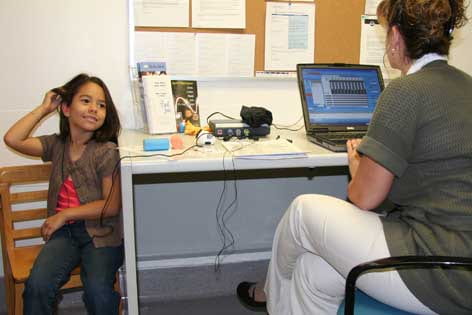UCI expands options for hearing-impaired
New technology in cochlear implants and hearing aids means children needn’t suffer from hearing loss, says UC Irvine Dr. Hamid Djalilian.

Ava Martin seems less nervous than her parents as the three sit in an audiologist’s office at UC Irvine Medical Center a few days after Labor Day. In August, the 6-year-old had surgery to place a cochlear implant in her right ear. Now Ava plays with toys while Ginger Stickney describes to Dave and Gabrielle Martin the tests that will gauge how their daughter’s auditory nerve is responding to the implant. But first Stickney must activate the device that could restore function to Ava’s right ear – an ability lost years ago due to a congenital inner-ear defect that’s also destroying the hearing in her left ear.
***
While a hearing aid amplifies sound, a cochlear implant is designed to bypass nonfunctioning or damaged cells in the inner ear and directly stimulate the auditory nerve. A receiver, electrode system and magnet – all the size of a quarter – are placed under the skin behind the ear. Electrodes are surgically inserted into the cochlea, the part of the inner ear that converts sound waves into electrical impulses that are conveyed to the brain and processed as sound. An external speech processor affixed to the scalp by magnets completes the device.
Originally intended to enhance speech recognition – as an aid to lipreading – cochlear implants these days contain multiple electrodes, enabling users to hear a range of pitches. “Now we can get people to recognize 80 to 90 percent of words,” Stickney says, “without visual cues.”
UCI treats an estimated 5,000 hearing-impaired people annually, with about four receiving cochlear implants each month, says Dr. Hamid Djalilian, who operated on Ava. The devices became available for adults in the 1980s, and children began getting them by the mid-’90s. Recent technological advances, particularly smaller processors, have made cochlear implants an option for more youngsters. Not all parents, though, are aware of this.
“We thought hearing aids were all that we could do, until we met Dr. Djalilian,” says Gabrielle Martin. “We were horrified that – with Ava’s condition – she would lose her hearing. It was just a matter of time.”
After Gabrielle did some research and the family consulted with UCI specialists, however, Ava became a candidate for the electronic device. Stickney, clinical director of the cochlear implant program at the medical center, says candidates’ hearing loss and comprehension of spoken words are evaluated. A speech pathologist assesses language capability, and a psychologist determines whether expectations are realistic.
“Sometimes parents think the cochlear implant will solve all their problems,” Stickney says. The Martins had no such illusions but wanted to improve their daughter’s chances of succeeding in school. Although Ava had developed language skills, they worried that the hearing loss would cause her to fall behind her peers.
Djalilian, director of neurotology and skull-base surgery, shares that concern. Hearing-impaired kids risk losing or never fully attaining language. “Children learn language up to age 9,” he says. “After that, one is unable to acquire those skills. The parts of the brain related to language are hardwired.”
The most critical time for language acquisition, though, is between the ages of 1 and 4, and some hearing centers refuse to implant cochlear devices in children over 4, deeming them too old to benefit. “Our philosophy is different,” says Djalilian. “We want to give every deaf child the best chance to acquire language – even if the hearing loss was discovered late.”
***
Ava places her cochlear implant’s external processor behind her right ear, inserts the bright-pink earpiece and leans back in the chair, hands behind her head. As Stickney activates the device, Ava breaks into a grin wide enough to expose two missing bottom teeth and signals a big thumbs-up.
She can understand her mother’s voice now without lipreading and hear such things as the air conditioner in her father’s car. More importantly, Ava will be able to attend school with the hope of keeping up with other kids her age.
“The cochlear implant has given her the ability to hear sounds at a normal level,” says Djalilian. It helps boost high tones while a hearing aid in Ava’s left ear boosts low tones. “Her brain can put information from the device and the hearing aid together in a way that makes sense.”
Stickney is pleased with Ava’s progress. “I think she’s off to a good start,” the audiologist says, though she notes that the fluctuating hearing in Ava’s left ear presents a challenge.
And the Martins? “We’re happy with it – ecstatic that she got it,” says Gabrielle of the implant. Ava smiles and chimes in: “Really happy.”